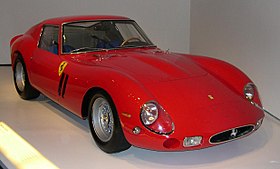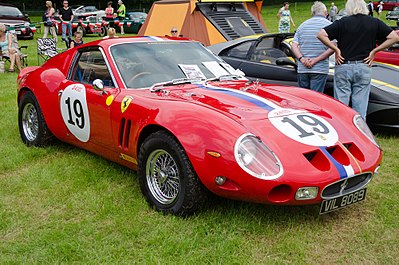Ferrari 250 GTO

| |
| Ferrari 250 GTO | |
|---|---|
| Manufacturer: | Ferrari |
| Class: | front-engined coupe |
| Production: | 1962 — 1964 36 or 39 produced |
| Successor: | Ferrari GTO |
| Body Styles: | Berlinetta |
| Engines: | 3.0 L V12 |
The Ferrari 250 GTO was a sports car and auto racing car made by Ferrari in the early 1960s. It is widely considered to be the quintessential Ferrari model, and one of the greatest sports cars - indeed, one of the greatest automobiles - of all time.
The numerical part of its name denotes the displacement in cubic centimetres of each cylinder of the engine, whilst GTO stands for "Gran Turismo Omologato", Italian for "Grand Touring Homologated."
In 2004, Sports Car International named the 250 GTO number eight on the list of Top Sports Cars of the 1960s, and number one as the top sports car of all time. Similarly, Motor Trend Classic named the 250 GTO as number one in their list of the "Greatest Ferraris of all time".
Development
The 250 GTO was designed to compete in GT racing. It was an orthodox (some would say conservative) evolution of the 250 GT SWB. Chief engineer Giotto Bizzarrini took the chassis from the 250 GT SWB and mated it with the 3.0 L V12 engine from the 250 Testa Rossa. After Bizzarrini and most other Ferrari engineers were fired in a dispute with Enzo Ferrari, development was handed over to new engineer Mauro Forghieri and designer Sergio Scaglietti. The widely-admired body was developed from work done by Bizzarini and Scaglietti and perfected in wind tunnel and track testing and, unlike most Ferraris, was not designed by a specific individual or design house.
The rest of the car was a well-balanced presentation of early-Sixties Ferrari technology: a hand-welded tube frame, A-arm front suspension and a live-axle rear end, disc brakes, Borrani wire wheels. The five-speed gearbox was a step forward, if not really revolutionary; the metal gate that defined the shift pattern would in turn become a tradition that is still maintained in current models. The interior was stripped-down and simple in the extreme, to the point where a speedometer was not considered necessary for the instrument panel.
Racing success
According to the FIA rules for sports car racing, at least one hundred examples of a car had to be built in order for it to be homologated in the GT class (as opposed to the less-restricted prototype class). However, Ferrari built only 39 250 GTOs (33 of the "normal" cars, three with four-liter 330 engines (sometimes called the "330 GTO" but properly the 330 LMB), and three "Type 64" cars with revised bodywork) but nevertheless the car was allowed to race in the GT class. Some say that Ferrari successfully argued that the model was technically a modification of the 250 GT SWB, some say that Ferrari's clout was such that it was better for the sport to allow the team to compete instead of dealing with a petulant (and crowd-depressingly absent) Scuderia Ferrari.
The car debuted at the 12 Hours of Sebring in 1962, driven by the team of American Phil Hill (the standing World Driving Champion) and Belgian Oliver Gendebien. Although originally annoyed that they were driving a GT-class car instead of one of the full-race Testa Rossas competing in the prototype class, the experienced pair impressed themselves (and everyone else) by finishing 2nd overall behind the Testa Rossa of Bonnier and Scarfotti.
The success was not a fluke; the 250GTO was an exceptionally capable racing car. At the time of its introduction it was (depending on choice of gears and final-drive ratio) most likely the straight-line fastest car on any race track; more subtly, but perhaps more important, it had no bad habits or nasty tricks in its wide performance envelope. In the best Ferrari tradition, it made normal drivers look excellent and gave great drivers an unsurpassable advantage. Years of development for its significant components, and traditional Ferrari robustness, also guaranteed that the car would last until the end of the race. In the end, the GTO won the World Manufacturer's Championship three years in a row: 1962, 1963, and 1964.
Production
The low production (39) allowed Ferrari to be selective about potential owners; if you were in the good graces of Ferrari himself, or his North American ambassador Luigi Chinetti, your $18,000 (early-1960s dollars, of course) would buy you the best GT racing car available at the time.
The 250GTO arrived as perhaps the last car that could compete on such a level and still act as something of a normal road car; more visibly, it was one of the last front-engined cars to be truly competitive at such a level. In the age before vintage racing, the 250GTO faced the same fate as any other racing car of its time: as it passed into obsolescence, some were kept as regional race machines, while others were used as normal (if barely-practical and thoroughly glorious) passenger cars.
Collectability and appreciating value
In the late Seventies and early Eighties, the focus of the "performance" of the 250GTO and other rare Ferraris turned out to be their rapidly-accelerating market value. As the auto industry struggled through new regulations and questionable marketing decisions, the unfettered performance machines of the recently bygone era took on a new desirability. There was also something of a paradigm shift; instead of being old but lovable racing cars, well-heeled collectors (Ralph Lauren among them) started to see the 250GTO and its brethren as a sort of drivable fine art, much like the coachbuilt luxury cars of the pre-World War II era.
This investment mentality reached an unreal peak in the late Eighties. As the wealth of certain members of the baby-boomer generation exploded and the stock market became a questionable investment, the market value of classic cars, especially Ferraris, went geometric - and as the much-touted great example of all the best traits of the breed, the asking price of the 250GTOs soared highest. One of them, seized by the FBI from a convicted drug dealer, was sold in a sealed auction in 1988 for approximately $2 million, which was considered outrageous at the time - and within three years would come to be seen as a good investment.
The money element, and the car's raw desirability and scarcity, have resulted in a number of faux 250GTOs being crafted on the base of more common Ferrari chassis; there are many more cars that look like 250GTOs running around today than were ever rolled out of the Scaglietti coachworks. Misrepresentations of original cars, with unscrupulous types attempting to sell them for full price, have been reported.
Prices peaked around 1991; although specifics are discreetly glossed over, it is common knowledge that a 250GTO traded hands in a private sale around this time for no less than fifteen million dollars.
Since then, the collector-car bubble has comprehensively burst, and the price for legitimate high-demand Ferrari models has steadily climbed again. Market value for a 250GTO in late 2004 can be safely estimated to be in the neighborhood of $6 million.
| Ferrari timeline, 1948-1967 | Ferrari road car timeline 1960s-1990s > | |||||||||||||||||||||
| Type | 1940s | 1950s | 1960s | |||||||||||||||||||
| 7 | 8 | 9 | 0 | 1 | 2 | 3 | 4 | 5 | 6 | 7 | 8 | 9 | 0 | 1 | 2 | 3 | 4 | 5 | 6 | 7 | 8 | |
| Sports | 125 S | 166 S+166 SC | 195 S | 212 Exp | 225 S | 250 MM | 250 Monza | 250 GT Tour de France | 250 GT SWB | 250 GTO | 250 LM | |||||||||||
| 159 S | 250 S | 250 Export | ||||||||||||||||||||
| GT | 166 Inter | 195 Inter | 212 Inter | 250 Europa | 250 GT Europa | 250 GT Boano | 250 GT Ellena | 250 GT Coupe PF | 250 GT Lusso | 330 GTC | 365 GTC | |||||||||||
| 275 GTB | 275 GTB/4 | |||||||||||||||||||||
| Spyder/Cabriolet | 250 GT | 275 GTS | 330 GTS | 365 GTS | ||||||||||||||||||
| 2 plus 2 | 250 GT/E | 330 GT | 365 GT | |||||||||||||||||||
| America | 340 | 375 America/MM | 410 Superamerica | 400 Superamerica | 500 Superfast | 365 California | ||||||||||||||||
